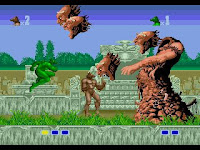System: Xbox 360, PS3, PC, PS2
Release: August 2008
Mercenaries 2: World in Flames is an action packed third person sandbox shooter made by Electronic Arts and Pandemic Studios. Taking on the same characters as the first game players choose between Jen Mui, Mattias Nilsson, and Chris Jacobs. Once again each character has a unique ability. Mui runs fast. Nilsson heals more rapidly, and Jacobs can carry additional ammo. This time the mercenaries find themselves in
Destruction is a major influence for the overall gameplay. Every building, vehicle, bush, and tree can be decimated. Don’t like that sky scrapper? Blow it up!
So everything can be smashed, cracked, and ruined. How then does one bring about this destruction? Like the first Mercenaries tons of tanks, cars, helicopters, and air strikes are at your disposal. Unfortunately the Russian Black Market is no longer available. Players must either find items out in the field, or purchase them from faction outposts. Throughout Venezuela there are plenty of vehicles to hijack that usually entail a short yet sweet God of War like mini game. Resources can also be extracted from various locations once the helicopter pilot Ewan is unlocked. If players don’t feel like scavenging, then they can check out the shops of five different factions—Pirates, Guerillas, Chinese, Allied Nations, and Universal Petroleum. Each offers various unique items and also provides contracts. The faction items cost money to buy, and everything requires fuel to deliver. Supplies that are in your “Stockpile” are distributed right into the heat of combat by your recruited helicopter and jet pilot.
 I can’t stress enough, the vehicles and air strikes are what make this game fun. GTA4 dose not have this many tanks and helicopters. No game has this variety of support items. This adds to the replay value. Beat the mission using a tank? Try it again in a helicopter, or completely devastate the area with a Carpet Bomb. The unique feel that each item has is truly impressive.
I can’t stress enough, the vehicles and air strikes are what make this game fun. GTA4 dose not have this many tanks and helicopters. No game has this variety of support items. This adds to the replay value. Beat the mission using a tank? Try it again in a helicopter, or completely devastate the area with a Carpet Bomb. The unique feel that each item has is truly impressive.
So the game is a blast, but it is no where close to perfect. The visuals are impressive at first, but those with an eye for detail will notice issues. Floating objects abound once base structures are destroyed, and two-dimensional trees are the standard animation at high elevations. Also the character models and cut scenes are not up to next-gen standards. Finally, the mission structure is rather limited for the next- gen versions. The PS2, oddly, has deeper more diverse contracts that actually take advantage of the entire map. For the other consoles and PC, outpost and delivery missions are the norm. Only about 40% of the contracts take advantage of the games strong points. The remaining filler will only be completed by diehard fans and perfectionist. These issues, and more, are not huge but take away from the overall experience. It would have been great to see that extra level of polish, and more contracts that do not involve capturing outposts or delivering supplies in pick-up trucks.
The other major short coming for Mercenaries 2 is the co-op limitations. Players can pair up to take on the various armed forces throughout  that occur in co-op are yet another ding to the already sublime graphics.
that occur in co-op are yet another ding to the already sublime graphics.
Mercenaries 2 is a fun game. Being able to destroy just about everything in









